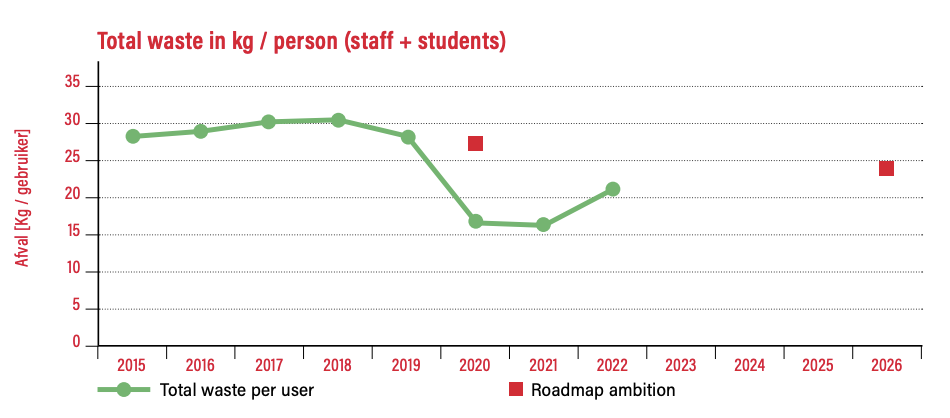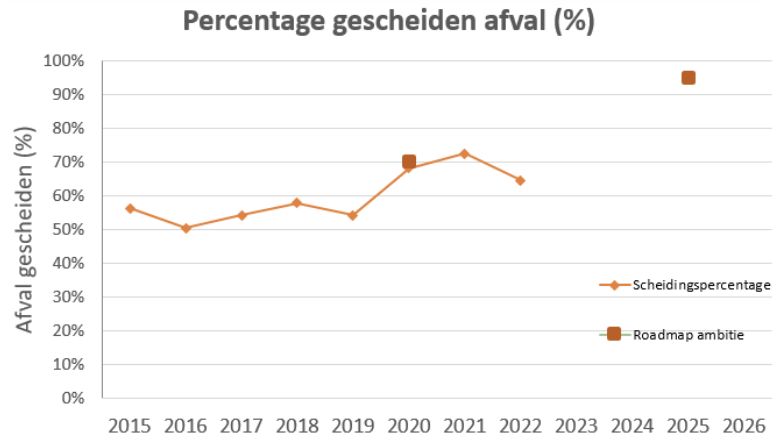Afval
Bij de RUG wordt al ons GFT en papier afval op gebouwniveau gewogen door de inzamelaar. Plastic en restafval wordt gewogen door middel van perscontainers en verkrijgen wij de cijfers van de afvalverwerker.
In 2019 is het afvalbeleid van de RUG herzien. Vanaf eind maart 2021 scheidt de RUG afval bij de bron. Dit betekent dat er niet alleen gebruikgemaakt wordt van nascheiding, maar de RUG-omgeving ook ingericht is voor afvalscheiding door studenten en medewerkers. Hiervoor wordt gebruikgemaakt van afvaleilanden.
Het restafval wordt verder gescheiden tot de grondstofstromen: koffiebekers, papier, PMD, GFT en een kleine restafvalfractie. PMD en restafval worden nagescheiden bij dezelfde afvalverwerker. De hoeveelheid niet-gevaarlijk afval is ten opzichte van voorgaande jaren met circa 30% gedaald. In de grafiek is de hoeveelheid afval in kg per medewerker + student weergegeven.

Nieuwe ontwikkelingen
De Facilitaire Organisatie werkt hard aan een nieuwe Europese aanbesteding voor het beheer van reststoffen. Hiervoor wordt samengewerkt met de Green Office en Arbo Milieudienst. De doelen voor 2025 die zijn opgenomen in het nieuwe afvalbeleid van de RUG zijn: 95% afvalscheiding in 2025 en 15% reductie van de totale hoeveelheid afval ten opzichte van 2020. Dit betekent ook dat we ernaar streven om al het ongevaarlijke afval circulair te maken door 2025. De RUG heeft een specifiek beleid ten aanzien van gevaarlijk afval.

In 2025 wordt het niet gevaarlijk afval opnieuw aanbesteed. In het Programma van Eisen wordt opgenomen dat afval op een duurzame manier wordt verwerkt en dat er gestreefd wordt naar het fossielvrij inzamelen van het afval vanaf 2023. Vanaf 2025 is in de binnenstad van Groningen en voor alle locaties van de RUG alleen nog emissieloze logistiek toegestaan. Dit is in lijn met het mobiliteitsbeleid van de gemeente Groningen, waarbij de logistiek in de binnenstad emissieloos moet zijn vanaf 2025.
Ambities
Vanuit de Roadmap Duurzaamheid 2021-2026 zijn dit de nieuwe ambities op het gebied van afval:
➔ Eind 2026 wordt 95% van het totale afval (gevaarlijk en niet gevaarlijk) gescheiden
➔ 15% reductie van het totale afval in 2026 t.o.v. 2019; (van 29 kg naar 25 kg/medewerker/student)
➔ Alle restafval circulair in 2026
Voorbeeld duurzaam afvalbeleid | Compactors
Een voorbeeld van een duurzame oplossing op gebied van afval zijn de ‘compactors’ op het Zerniketerrein. Deze op zonne-energie werkende afvalperscontainers voorzien voor honderd procent in hun eigen energiebehoefte. Ze persen het afval samen en kunnen zo tot vijf keer meer afval bevatten dan een gewone afvalbak. Door de verhoogde capaciteit vermindert het aantal keren dat de bak geleegd moet worden. Dat draagt bij aan een vermindering van de CO2-uitstoot.
